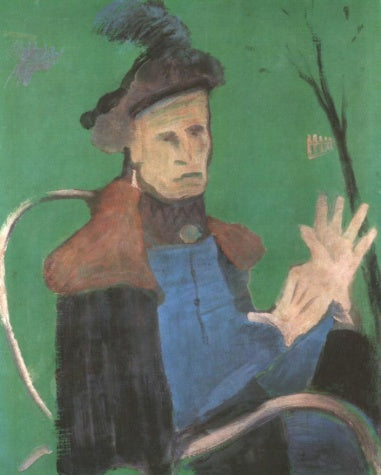Description
The painting "Portrait of Countess G. Z." (1931) by Istvan Farkas constitutes an intriguing work of the art of the twentieth century, reflecting the mastery and the unique style of the Hungarian painter. With a combination of dream and realistic elements, Farkas manages to capture the essence of the portatted aristocrat, immersing ourselves in a world that ranges between mystery and sophistication.
The composition of the work is organized in such a way that the main figure, Countess G. Z., occupies the center of the canvas. His upright posture and the expression of his face reveal us a personality of great presence and character. The Countess's face, in detail worked, contrasts with the most schematic and abstract background, emphasizing its importance in the work. His eyes, big and penetrating, seem to cross the viewer, implying a psychological depth that invites reflection.
One of the most fascinating aspects of this painting is its use of color. Farkas uses a limited but effective palette, where dark and sober tones predominate, creating an atmosphere of solemnity and elegance. The background, composed of an interwoven of geometric shapes in tones of gray and blue, adds a dimension of modernity to the work, taking off from pure realism and suggesting a connection with the European avant -garde of the time.
The Countess's dress, which combines brown and green tones, is presented with a stylized, almost architectural touch, which reminds the fashion of the time, but with an artistic interpretation that brings the pictorial. The contrast between the detailed human figure and the abstract background suggests a duality between the eternal and the ephemeral, the tangible and the intangible.
Istvan Farkas, born in 1887 in Budapest, was a painter of great talent whose style was influenced by his studies in Paris and his interaction with the circle of artists of the Paris of Paris. In his works, he often combined surreal elements with almost traditional detail, managing to create a distinctive and recognizable style. Farkas, victim of the Holocaust, left an artistic legacy that is still the object of admiration and study.
"Portrait of Countess G. Z." It is also a reflection of the historical context in which it was created. The thirty -year Europe was mired in great social and political agitation, and this is subtle reflected in the sense of restlessness emanating from the work. The serene but firm posture of the Countess can be interpreted as a metaphor for resistance and dignity in turbulent times.
Within the framework of art history, Farkas's work is at an intermediate point between post -impressionism and surrealism. His ability to merge the outside world with the inner world of the portrayed subject is a mark of his genius. Contemporary painters to Farkas, such as Chaim Soutine and Amedeo Modigliani, also sought this balance, although each one had their own distinctive approach.
The "Portrait of Countess G. Z." It is undoubtedly a work of art that deserves to be observed and analyzed carefully. Through its color treatment, its composition and the intense introspection it offers on its subject, Istvan Farkas invites us to a meditation on the nature of the identity and transit of time. It is a testimony of the elegance and depth that art can achieve when done with true mastery.
KUADROS ©, a famous paint on your wall.
Hand-made oil painting reproductions, with the quality of professional artists and the distinctive seal of KUADROS ©.
Art reproduction service with satisfaction guarantee. If you are not completely satisfied with the replica of your painting, we refund your money 100%.

